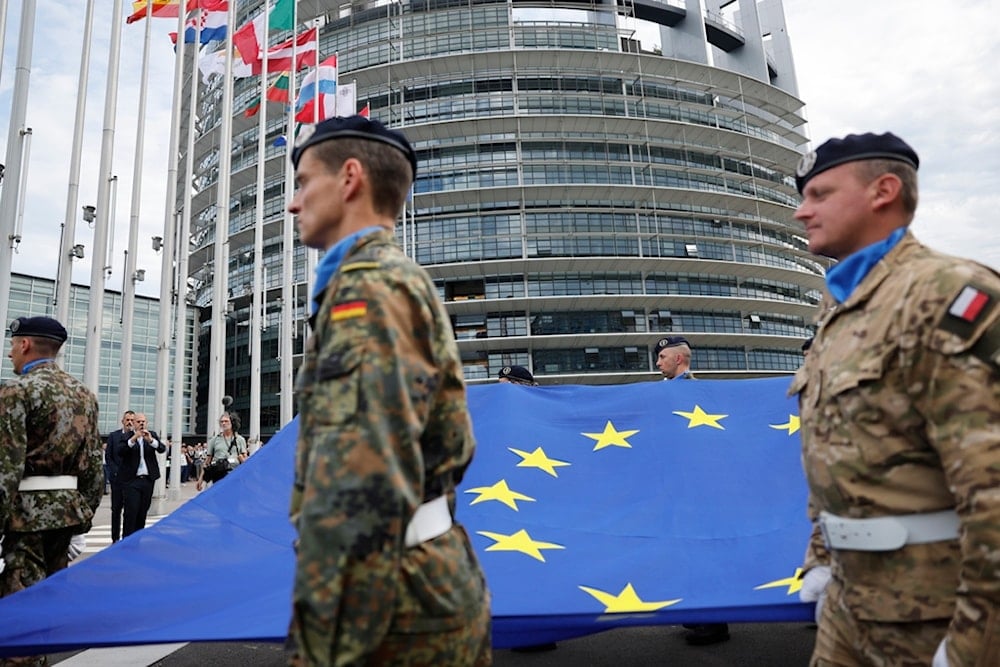EU allocates $315mln for defense procurement projects among members
Executive Vice-President of the European Commission Margrethe Vestager says this was the first initiative that "supports EU states in commonly procuring defense products."
-

Military hold the European Union flag as they participate in a flag-raising ceremony for the beginning of the 10th legislative term in front of the European Parliament in Strasbourg, eastern France, Monday, July 15, 2024 (AP Photo/Jean-Francois Badias)
The European Commission has granted money for five cross-border defense procurement projects aimed at streamlining and strengthening collaboration among EU member states. Each of these projects, backed by the European Defense Industry Reinforcement via Common Procurement (EDIRPA), will get EUR 60 million, for a total of EUR 300 million ($315 million) in financing.
This joint procurement initiative is aimed at improving defense capabilities while achieving "economies of scale," allowing Member States to obtain vital defense supplies more affordably and benefit from enhanced interoperability, allowing for more effective cooperation across national borders.
Executive Vice-President Margrethe Vestager said this was the first initiative that "supports EU states in commonly procuring defense products," detailing how more than 300 million Euros are being injected into 5 projects to address urgent defense capability gaps.
The programs include air and missile defense systems, armored vehicles, and ammunition. For air and missile defense, the 'MISTRAL' and 'JAMIE' programs will provide short and medium-range systems to counter aerial threats, such as airplanes and drones. In the realm of armored vehicles, EDIRPA is working with the Common Armoured Vehicle System (CAVS) to improve personnel protection and mobility.
To alleviate ammunition shortages, two further projects will focus on the procurement of 155mm artillery rounds, which are critical for operational preparedness. The total procurement value of these projects exceeds €11 billion, demonstrating the Commission's involvement in driving significant defense investments.
The Commission received 12 proposals before the July 2024 deadline, demonstrating a considerable interest in joint military procurement. While five projects were chosen, promising concepts were placed on a reserve list, possibly suitable for future financing. Member states may opt to finance these additional initiatives with unspent EU funding.
This effort, including 20 EU Member States, includes certain nations that are participating in cooperative defense procurement for the first time. With an average of six nations participating in each project, EDIRPA demonstrates rising interest in a united European strategy for resolving defense capability gaps, particularly those worsened by resource transfers to Ukraine.
Vestager stated these measures "will allow to provide better value for money for national defense budgets, improve the interoperability of European armed forces, strengthen our industry, and make Europe better prepared to face defense threats."
EDIRPA, which was enacted as a short-term reaction to the war in Ukraine, enables cooperative procurement through 2025. The Commission has also suggested continuing this strategy beyond 2025 through a European Defense Industry Programme (EDIP), which would help to unify demand and improve EU defense capabilities
Europe must boost defenses amid US foreign policy shift: Le Monde
An opinion piece published by writers Alexandr Burilkov and Guntram Wolff for Le Monde on Thursday argues that Europe must urgently strengthen its defense capabilities amid increasing isolation, a sentiment underscored by Donald Trump's recent electoral victory in the US presidential race.
The authors contend that Europe's reliance on American military protection is no longer sustainable, as the US appears set to shift its focus toward "Israel" and the geopolitical tensions with China, deprioritizing Europe's security needs.
Burilkov and Wolff highlight the limitations of America's military might, which they argue is compromised by a "crumbling defense industrial base."
This weakened foundation, they note, challenges the US' ability to fulfill its global defense commitments, especially given the lengthy and high-intensity nature of modern warfare, which demands robust industrial capacity to sustain equipment and personnel over time.
While the US continues to support Ukraine's war with Russia, its industrial resources are struggling to keep pace with those of Russia.
This, the authors argue, exposes a critical vulnerability for Europe, which could find itself without sufficient support should American commitments waver.

 4 Min Read
4 Min Read








